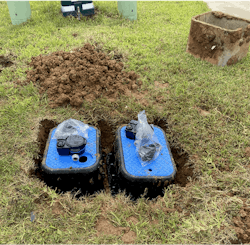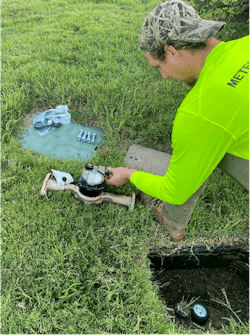Texas Looks for State-Wide Water Metering System Improvements
About the author:
Vince Drieling is a Director Of Business Development at Ameresco. Drieling can be reached at [email protected].
As communities strive to make smart investments in infrastructure repair, sustainability focused infrastructure upgrades provide the best path for reaching lower utility costs and improving utility operations. Across the state of Texas, municipalities are taking steps to address outdated infrastructure systems, starting with water infrastructure. Adopting new advanced metering infrastructure (AMI) and automatic meter reading (AMR) systems are effective ways that cities are becoming smarter with their utilities and associated distribution systems. In addition to customer service benefits, AMI systems provide data transparency and historical usage patterns that can be used to determine irregularities in utilities consumption and losses for citizens and city infrastructure.
What Are Smart Water Metering Systems?
These metering systems use advanced technology to read, monitor, and maintain water, electric, and gas utility distribution systems. A network of smart meters can communicate utility data and act as a centralized database for local governments and citizens. Smart water refers to a movement in the water industry to implement emerging technologies for improved infrastructure systems. These technologies can provide the data and analytics to facilitate data driven decision making for critical infrastructure management and maintenance based on factual information.
The choices made by local and state governments surrounding utility specific infrastructure will have drastic implications for citizens all over the country. In the state of Texas, cities have experienced all types of issues when dealing with utility metering systems, including inaccurate data, outdated equipment, a shortage of labor force for on-site visits, and increasing maintenance and costs. When mechanical meters age, their accuracy degrades, which results in the under-reporting of consumption data.
The improvement of advanced metering systems in cities can provide numerous benefits for both cities and citizens, including enhanced customer service, transparency of utilization data for all customers, increased operational efficiencies, system data analytics for data-based decision making, as well as a reduction in overall operational costs.
RELATED: What is Smart Water Technology?
Replacing an Outdated System
One city that has shifted its efforts to address these ongoing issues is the City of Seabrook, Texas. In an effort to replace outdated water metering systems and provide better services to their citizens, Seabrook has turned to Ameresco, a proven project integrator, for help with technology selection, turnkey implementation, and funding of a new water meter reading system.
Ameresco, Inc., a cleantech integrator specializing in energy infrastructure, water infrastructure and renewable energy, has completed more than 15 smart infrastructure projects in Texas in the last 5 years. The company was selected by Seabrook to install a comprehensive smart metering infrastructure improvement project that includes the installation of solid-state water meters and an AMI system.
As part of the project, Ameresco installed 4,110 water meters in place of the city’s existing meters. Prior to the partnership, the City of Seabrook replaced existing water meters and accessories only when meters failed. Some meters in the city were over 20 years old. Aging mechanical meters contributed to loss and unaccounted for revenues and operational inefficiencies. By replacing the water meters proactively, Ameresco is helping the City of Seabrook to restore accuracy to its water distribution system and transparency in its reporting data. During the construction process, Ameresco created additional value for the City of Seabrook by replacing its damaged meter boxes and valves to improve the reliability of its water distribution system.
The improvement of meter precision and long-term sustainability will allow the City of Seabrook to more accurately account for end-user consumption, which would otherwise go unmetered, and better capture lost revenue. Following implementation of the proposed upgrades, the city will realize an annual cost savings of more than $50,000.
Making the Most of Public Money
Like many cities in Texas, the City of Seabrook was facing the rising costs of water and operational challenges associated with providing its citizens the data transparency they were looking for as it relates to their water usage. Pressure from citizens to provide faster, more accurate and transparent data on utility bills is driving cities to find solutions to allow them to provide these enhanced services to customers. Additionally, outdated meters and failing utility infrastructure across the state are driving up operational costs and providing inaccurate results. This leads to frustration for citizens and cities losing revenues they were counting on to keep their utility infrastructure working properly and the ability for city staff to provide the services their users expect.
Preceding the implementation of the now updated AMI system in Seabrook, the city faced challenges maintaining its water infrastructure with the lack of funding for additional staff. Outdated water metering systems that were put in place years ago required workers to visit the physical site where these meters were located and take manual readings of water consumption.
Upgraded AMI systems now capture metering data every 15 minutes and transmit the proper information several times every day, saving labor costs and allowing maintenance staff to focus on other city sectors that may require more attention. Upgrading to the latest smart metering technology helps cities stay on the cutting edge of sustainability and is helping pave the way for similar projects in other cities nationwide.
What Smart Metering Systems Mean For Cities
The improvement of data transparency can lead to more accurate billing. With outdated water metering systems, cities have higher values for loss and unaccounted for revenues as well as higher than required operational cost. Over time, this has cost cities that cannot afford up-to-date infrastructure millions of dollars in underpriced water bills, water losses from leaky fire hydrants, leaky faucets, broken pipes, and aging inaccurate meters.
The savings that cities see over time from the implementation of updated AMI systems, and increased data accuracy are reasons why cities are reaching out to companies with smart metering technology. Further down the line, these savings have the potential to be used to further other municipal initiatives that cities may see fit for extended sustainable and resilient solutions.
Through the help of Ameresco, Seabrook was able to use data to identify issues and see where improvements could be made. Working closely to make sure that citizens knew exactly what was being suggested and considered throughout the process, smart metering infrastructure implementation enabled up-to-date reading, collection, and management of utility data to provide enhanced customer service, transparency, and accountability.
The water reports that were gained from these systems can then be used to show residents their conservation levels and how they are using their water, thereby empowering the citizen to make better choices on conserving water or other utilities.
Environmental Implications
The updated water metering systems put in place can be used as an exemplary model for future AMI projects. Regardless of the size of the AMI project, data transparency is a key component to help municipalities identify opportunities to create savings, conserve water, and be more transparent with their citizens.
Water conservation and reducing water usage are becoming increasingly more prominent, especially for regions with climates that are more susceptible to droughts. Other municipalities in Texas that are taking serious strides in water conservation and have adopted similar AMI/AMR upgrades include the Bellmead, Mesquite, El Campo, Woodlands Water, and more. Creating water-specific improvements far surpasses just any one state’s goals and there is much more work to be done.
Regardless of where these sustainability projects are taking place, the goal remains the same: incorporating data transparency to implement cost savings will benefit the citizens and communities as a whole. As water prices increase and supplies are constrained, cities’ focus on conservation efforts and sustainable infrastructure is something that cannot be overlooked.


